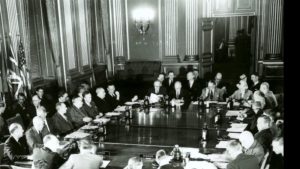
EURACTIV.com: Try to imagine what life was like 70 years ago.
The Second World War had ended four years prior, the Cold War began and went on for more than four decades. On April 4, 1949, 12 countries forged a defence alliance that would bond Western Europe with North America. It brought together like-minded nations who shared a commitment to the values of liberty and democracy.
Formally inaugurated by the Washington Treaty, the North Atlantic Treaty Organization was created for political union and to defend members from threats, and continues to do so now.
Chris Lombardi is the vice president of European Business Development at Raytheon.
Today, NATO marks its 70th birthday. Defence Ministers will toast the occasion in Washington D.C. at a special gathering to reflect on NATO’s legacy, to take stock of where it stands, and to look ahead to its future. There are three things that remain important in keeping NATO relevant and prepared to address emerging threats: (1) Early and ongoing identification of capability gaps (2) Diversity in thought through industry collaboration, and (3) Smart and efficient spending.
- Regardless of NATO’s achievements, we cannot be complacent. The world faces the most complex and rapidly evolving security environment since the end of the Cold War. Both China and Russia are ramping up their defence investments. State and non-state actors have increasing access to disruptive technologies, from cyberspace operations to swarm drones. If NATO is to stay ahead of the threats, it must identify its capability gaps, while continuing to adapt and evolve. As NATO’s latest annual report points out, “a more uncertain security environment requires that all Allies continue to invest more in defence, develop the right military capabilities and make the necessary contributions to NATO’s military operations and missions”.
- Defence industry collaboration continues to be instrumental in ensuring that NATO is equipped for the demands of today and tomorrow and can count on the most technologically advanced solutions. A good example is the National Advanced Surface-to-Air Missile System (or NASAMS), a medium-to-long range air-defence system, selected by ten countries including the United States, Norway, Spain, Lithuania and the Netherlands. NASAMS emerged from a longstanding industrial partnership between Raytheon and Norwegian partner Kongsberg. Similar partnerships are also enhancing the Patriot integrated air and missile defence system, which is used by more than five NATO nations and protects allies against incoming aircraft, cruise and ballistic missiles. The Evolved SeaSparrow Missile (ESSM) programme, developed jointly by 12 member-nations of the NATO SEASPARROW Consortium, highlights the advantages of inclusive cooperation and brings transformational anti-ship missile defence capabilities to NATO and allies. Industrial cooperation is crucial in bringing innovation and efficiencies. Working with international partners, especially small and medium-sized enterprises, helps us identify and address these emerging threats. It is no surprise that Article 2 of the North Atlantic Treaty says members should “seek to eliminate conflict in their international economic policies and will encourage economic collaboration between any or all of them”.
- As NATO leaders acknowledged at last year’s Brussels Summit, it is not just about spending more. It is about spending smarter and more efficiently. That is possible through international cooperation in research, in procurements, and in threats and capabilities assessment. Industrial players such as Raytheon actively support this collaboration. For many years we’ve worked with our partners across Europe to bring our customers innovative solutions at the lowest possible costs. Continued investment in solutions that are interoperable and complementary will help reduce redundancy and ensure that we take a layered approach to our defence and security.
For 70 years, NATO continues to play a crucial role in our defence and security. The alliance remains a proven example of what military-to-military cooperation and integration can achieve. Soldiers from 29 countries train together, fight together, and address threats together. NATO has stabilised and promoted democracy in Europe. The emerging threats may vary, but if NATO continues its collaborative, innovative practices then it will remain as relevant today as it was in 1949.

